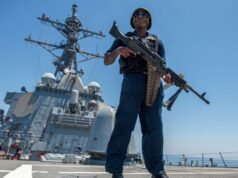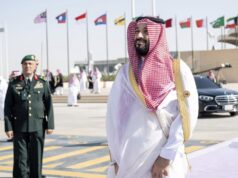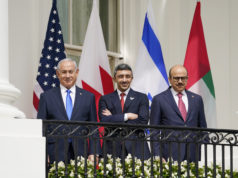Money, they say, can’t buy you everything. But in the conservative Arab states of the Persian Gulf (or the Arabian Gulf as they prefer to call it), money can buy a lot.
What is the tallest building in the world? The Burj al-Khalifa in the sheikhdom of Dubai. What is one of the best airlines in the world? Washington, DC friends vacationing in Asia recently chose to fly there with Qatar Airways via Doha. The newness of aircraft, quality of on-board service and well-timed connecting flight trumped any political misgivings, such as Qatar’s support for Hamas in Gaza and the weapons it gives to some of the worst jihadists in Syria.
This prosperity, of course, is a consequence of oil, but in regional terms, the Gulf Arab states—Saudi Arabia, Kuwait, Bahrain, Qatar, the United Arab Emirates, and Oman—found oil late in the game. Oil was first discovered in Iran in 1908. The giant oilfield at Kirkuk in northern Iraq was found in 1927. The first oil on the southern side of the Gulf was found in Bahrain in 1931. Saudi Arabia, which now has the largest reserves of conventional oil in the world—between a sixth and a quarter of the total depending how you do the math—found its first oil only in 1938. Production did not take off until 1941. Oil was not found in Abu Dhabi, the leading emirate of the UAE, until 1958. It is now estimated to have around 6 percent of the world’s oil. Not bad, considering its population is less than one million.
Apart from hydrocarbon riches, the distinguishing feature of the conservative Gulf Arab states is their small populations. Saudi Arabia is the largest with a population of about 27 million though this probably includes at least 7 million expatriate workers. The smallest is Qatar, with about 2 million people but perhaps as few as 10 percent, 200,000, actual Qatari citizens.
So it is hardly surprising that these fabulously oil-rich countries and, in the case of Qatar natural gas-rich, have now emerged on the world stage. Dubai, Abu Dhabi, Doha and Manama (Bahrain) are now iconic city-states, joining countries like Singapore and Hong Kong. Yet their entrance coincides with their region collapsing into turmoil. They have only been nation-states for a few decades yet their immediate future, what with an almost-nuclear Iran and the turmoil of the “Arab Spring,” is uncertain. To make matters worse, the trend line is bad. Ten, or more likely 20 years ahead, there is predicted to be an energy glut in North America (Canada, the U.S., and Mexico.) This will hammer oil and natural gas prices. So what if, collectively, you have more than 30 percent of the world’s oil and more than 20 percent of the world’s natural gas? Lower prices would certainly be to the benefit of the developed world but probably a disaster to the relatively undiversified economies of the Gulf Arabs.
There is a major “but” in this sweep of analysis. The Gulf States, loosely grouped together since 1981 in the Gulf Cooperation Council or GCC, have seen crises come and go, but, with the exception of Saddam Hussein’s 1990 invasion of Kuwait, have themselves been spared political catastrophe. Indeed, one could make the argument—and quite a few people do—that their quasi-monarchial-but-listening approach to government and administration has worked well. It hardly fits into the democracy playbook of liberals in the United States and Europe, but their general success has served to highlight of deficiencies of 1950s and 1960s Arab nationalist revolutions in Egypt, Syria, Iraq, Yemen, and Libya.
The major problem would appear to be the growing internal contradictions among the GCC member states. In early March 2014, Saudi Arabia, Bahrain, and the UAE withdrew their ambassadors from Doha to protest Qatari meddling in the internal affairs of the other countries. Apparently there had been a row about this last year, which had led to an agreement in late November 2013. But Qatar was not living up to its side of the bargain. The root cause of the crisis was Qatar’s support for the Muslim Brotherhood, though this was unstated. Indeed, the November 2013 pact had never been revealed and the announcement of the withdrawal of ambassadors only emerged in a communiqué issued at the end of a meeting of GCC foreign ministers in Riyadh.
Such a public schism opens to discussion consideration of whether the GCC as such will continue to exist. It wouldn’t be the first shakeup in national boundaries. When the British left the Gulf in the early 1970s, they created the UAE out of the emirates of Abu Dhabi, Dubai, Sharjah, Ras al-Khaimah, Fujairah, Ajman, and Umm al-Quwain. Qatar and Bahrain were originally intended to be part of the confederation as well but could not agree with the others on the terms.
Taking each member state in turn:
Saudi Arabia
The kingdom is facing a succession crisis. King Abdullah is 91 years old this year and his half-brother and designated replacement, Crown Prince Salman, is 78. Neither man is in good physical health. There are particular concerns about Salman’s mental abilities. Competition to replace either will likely be intense from sons and nephews, many of whom are more privileged than they are able. Stability in the kingdom is maintained by conservative attitudes and the generous distribution of subsidies and government jobs. If the oil price falls, the government’s ability to maintain these handouts will be lessened.
Uncertainties for the future include a drop in oil exports as more energy is consumed at home. The populace has become used to highly subsidized prices for gasoline and electricity. Re-educating them will be a challenge. The main foreign threat is Iran, which Riyadh sees as trying to achieve hegemonic status in the Gulf area. On the other side of the kingdom, Yemen is also watched closely because its population probably is larger than that of Saudi Arabia but is much poorer. Within Saudi Arabia, income disparity is an issue with many citizens living in comparative poverty. The tribes along the border with Yemen are suspected of dubious loyalty. On the other side of the country, on the Gulf coast, the population is largely Shiite, co-religionists of Iran and the neighboring island of Bahrain. Saudi Shiites are economically and politically disadvantaged. In addition, hardline Saudi Sunni clerics regard Shiites as not proper Muslims. The Saudi authorities handle the issue carefully but often badly. Any civil unrest could have wider consequences, as the area is also the epicenter of Saudi oil production and export.
Kuwait
The ruler is Sheikh Sabah al-Ahmad al-Sabah, 84 years old, with a lifetime of government service and experience but now in poor health. The authority of the al-Sabah ruling family is limited by the high standing of other prominent families and a political system that makes for gridlock. The national assembly, the oldest established parliament-type system in the southern Gulf, is divided among hardline Sunnis, tribal elements, and Shiites, with a leavening of technocratic types. Once the most modern emirate in the Gulf, Kuwait has been overtaken by Qatar and the UAE, partly a consequence of never really recovering from the shock of Saddam Hussein’s invasion in 1990. There must be a concern that next time, American forces will not come galloping to the rescue. When Sabah retires or dies, the ruling family will nominate possible replacements but the final choice will be a compromise with the members of the national assembly.
Bahrain
The island state has been wracked by political turmoil since February 2011 when pro-democracy supporters, aroused by the “Arab Spring” in other parts of the region, staged protests. The demonstrations rapidly took on a sectarian hue. The Sunnis disappeared, making the events into Shiite confrontations with Bahrain’s Sunni Muslim security forces. The main development since then has been the Shiites splitting into those advocating violence and, the apparent majority, those confining their activities to peaceful protests. A secondary, and probably more significant, change has been the emergence of Iranian backing for the violent groups.
The initial protests had prompted the intervention of Saudi paramilitary and UAE police reinforcements. Neither group actually was involved directly in countering the demonstrations, though in March 2014, an Emirati police officer died when an improvised bomb exploded near a Bahrain police unit. Political reconciliation has been thwarted by differences within the Bahrain royal family on whether compromises should be made. The lead conciliator is Crown Prince Salman but he is opposed by hardliners, including the minister of the royal court and the commander-in-chief of the Bahrain Defense Forces, collectively known as the Khawalid. King Hamad bin Isa al-Khalifa vacillates between the two factions. Failing political reforms, the more likely outcomes include more violence and fresh involvement by Saudi security forces. The House of Saud is anxious that violence in Bahrain does not spread to the kingdom and that political reforms do not encourage demands for matching gestures by Saudi Shiites. An outside possibility is that Saudi Arabia will seek political union with Bahrain.
Qatar
The “bad boy” of the GCC, a status achieved under Sheikh Hamad who abdicated in June 2013, is an even more accurate label for his son and successor, Sheikh Tamim bin Hamad al-Thani, who is just 33. The country appears to be proud of its reputation for causing trouble whether it is allowing a platform for radical Muslim preacher Yousuf al-Qaradawi, supporting some of the worst jihadists Syria, or backing the Muslim Brotherhood in neighboring UAE. Having agreed to behave better at a meeting with King Abdullah of Saudi Arabia in November 2013, Sheikh Tamim then failed to deliver, prompting the withdrawal of their ambassadors by Saudi Arabia, Bahrain and the UAE in March 2014. Having the world’s largest reserves of natural gas after Russia and Iran, as well as being the biggest exporter of liquefied natural gas (LNG) funds a lot of mischief as well as building soccer stadiums for the 2022 World Cup. The interesting question may be how long Saudi Arabia will put up with such nonsense. The al-Thani are a large clan and many members are excluded from political power. Hamad’s authority was questioned because he gained power by overthrowing his father, a reclusive alcoholic. Could Riyadh—would Riyadh—fund a coup in Doha? The Qatari military is perhaps one of the few armies that the Saudis could actually defeat.
United Arab Emirates
The ruler, Sheikh Khalifa, is “stable” after a recent stroke but had essentially already handed over the strings of power to his crown prince and half-brother, Sheikh Muhammad bin Zayed, who is pro-American but, like many Gulf leaders, deeply skeptical of the Obama Administration. MbZ, as he is known, represents the new generation of Gulf leadership. The test will be how much he will be constrained by any need to maintain GCC consensus. Much is made of the UAE’s persistent dispute with Iran over three islands (Abu Musa, Little Tumb, and Greater Tumb) seized by Iran in 1970. MbZ’s views on these islands may be more conciliatory than thought, but sovereignty is claimed by the UAE member sheikhdoms of Sharjah and Ras al-Khaimah and any compromise may threaten the confederation. Less noticed are two sources of territorial friction with Saudi Arabia—Riyadh’s seizure of land between Qatar and the UAE, removing the common border, and Saudi insistence that a huge oil field on the border lies totally within Saudi territory. The biggest threat is any military confrontation with Iran, which would ruin the commercial viability of Abu Dhabi and Dubai, the UAE’s cash-cows.
Oman
Sultan Qaboos is the odd-man-out of the Gulf. He usually shuns GCC meetings. He takes positions unhelpful to the U.S.—until, of course, he could be helpful to Washington by facilitating the secret talks with Iran before the diplomacy on the nuclear deal opened up. In socio-economic terms, Oman has got enough oil and gas to keep its relatively large population—about 3.1 million—happy. It is the one GCC country that had genuine “Arab Spring” type events in 2011 with riots by discontented youth quashed by a combination of firmness and government handouts. Qaboos believes his people love him. Perhaps most do, perhaps not. His unmarried status and lack of any heirs is a source of disquiet and occasional ridicule. At 74 years old, the question of “who will succeed Qaboos?” is becoming increasingly relevant. And Oman’s strategic position, on the southern side of the Strait of Hormuz, will remain vital for Gulf energy flows even if the U.S. becomes effectively energy independent.
All the GCC states have had and continue to have a dependence on the United States. None of them probably think they can rely on Washington for much longer, and certainly not forever. The sensible way forward would be to develop their unity—but this isn’t going to happen. Alternatively, they can look for another security partner. China is the name that springs to mind but there is little immediate evidence that this is going to happen. There remains the prospect of cutting an unpalatable deal with Iran. So far, perhaps with the exception of Oman and perhaps Qatar, this option is being rejected.
It makes for a worrying future.
Simon Henderson is the Baker Fellow and Director of the Gulf and Energy Policy program at the Washington Institute for Near East Policy.





